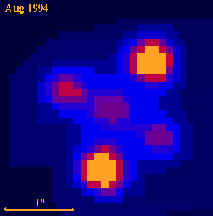
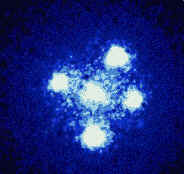
| Fun
with Einstein's Cross Ray Cash
Or jump to: |


Considered by most to be one of the ultimate deep-sky conquests using any large scope, I thought I would look for this gravitationally lensed quasar with my equatorially-tracking 17.5 reflector. Image on left from the William Herschel Telescope (note 1-second scale); right image from the Hubble Space Telescope. Bottom image is also from the Hubble Space Telescope (this image is hyperlinked, if you want to learn more about it).
As usual, I used Megastar to generate three star charts:
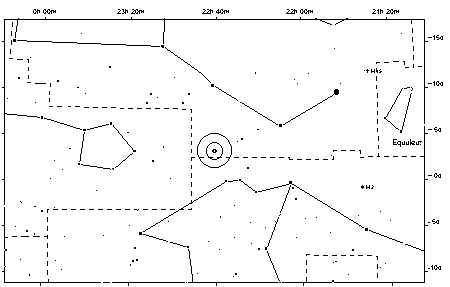
A thirty-degree "naked-eye" field;
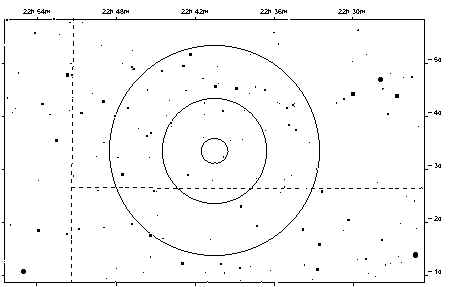
a five-degree "finder-field";
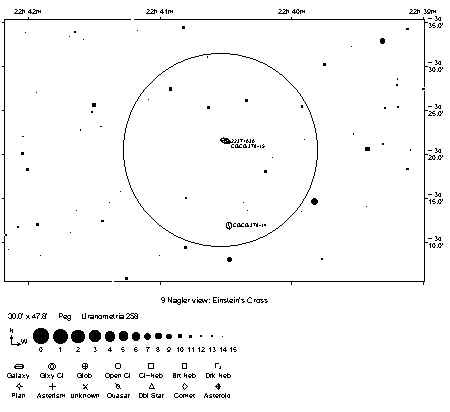
and, finally, a 30-minute "9-Nagler" field (circle is 22'). Unfortunately, when the time came to look for this object (in the wee hours of 7/15-16/99), I couldn't find the above charts! So, I reverted to the star-hopping sources I employed before I had any star-charting software, in a word: Uranometria. Page 258 allowed me to get very close to this object, but before I go further, let's have some details:
Quasar 2237 +030 shines at magnitude 16.8; its four components are lensed through a massive (though distant) galaxy's core. This is the combined magnitudes of the individually lensed elements; these range as follows: 17.36; 17.39; 18.43; and 18.72! The galaxy CGCG 378-15 shines at magnitude 15.1 ( all magnitudes are photographic, of course). Furthermore, this galaxy's overall size is much larger than the lensed quasar: 1.1' x .5' (or .7' x .3', depending on the source) compared to 1.8" x 1.6"--that's minutes of arc, versus seconds of arc in size! Therefore, unlike the heavily processed images above, I would have no hope of seeing dark space between the lensed Quasar--even if my scope could detect 17.4 magnitude stellar sources and could split 1.8 seconds of arc in less than ideal "seeing!"
So: what I was looking for was a very tiny, faint galaxy; most likely only to be seen with averted vision. And through this galaxy's core I was hoping to see some irregularity caused by (by all reasonable standards) beyond-averted-vision magnitude 16.8 (combined?) quasi-stellar source(s)!
Conditions at my site were quite ideal, by the way: 7200 feet altitude; seeing 8 on a 10 scale; transparency at least 6.5 magnitude. These conditions prevailed for both nights I looked for/at this object: 7/15-16 and 16-17/99. The only hindrance was a little wind which jiggled the telescope from time to time, and which became annoying, especially at 417x. Also, at two or three in the morning (when I observed), my desired object was still a couple of hours from the meridian... In other words, future months will place Einstein's Cross higher--and more favorably--in the sky...
I reset my equatorial platform--this would give me 73 minutes of uninterrupted searching and viewing. Remember: I had misplaced my Megastar charts, so I was instead on page 258 of Uranometria. After what seemed like an awful long time, I finally became convinced my target was somewhere within the eyepiece field of my 9-Nagler (222x; 22' FOV) eyepiece. I began flicking my eyeball around looking for a faint fuzzy... And, sure enough, a galaxy popped out at me. I centered it, plopped in my 4.8 Nagler (417x; 11.8' FOV), and began studying it for more detail. An even, oval, north-south glow using averted vision; only fleetingly able to view with direct vision. Some mottling? Irregularity? Perhaps, but these "glimmerings" were probably due to the same phenomena that causes stars to twinkle: less than ideal "seeing." I called Steve Gottlieb and Jim Shields over to see if they could confirm the field, or galaxy (both have seen Einstein's Cross--or the foreground galaxy--before). Neither were convinced this was indeed the foreground galaxy. I made a sketch of the field stars, and called it a night.
The next day I booted up Megastar, pulled out my drawing and matched (much to my surprise) my crude drawing with M-star right away. It seems I was in the right field after all, but aimed at the wrong galaxy, only 10.4-minutes of arc south (well within the field of view of my 9-Nagler--even my 4.8 Nagler) of my intended target! Hmmm... Why didn't I see the other galaxy? Why don't others mention another galaxy--in the same field--in their notes? The stats M-star give for CGCG 378-14 are: Magnitude: 15.7 Size: .8' x .6'. RA/Dec: 22 40 28.7; +03 11 51. The Quasar bearing galaxy's vital statistics, are, by the way: Magnitude: 15.1 Size: 1.1' x .5' RA/Dec: 22 40 30; +03 21 30. Here is a DSS photo of the area:
|
|
|
|
|
The next day, I found (actually my wife found), my heretofore missing Megastar charts! Don't ask me how they got there, but they were sitting next to a dumpster at the SFSU Field Campus! This made searching for the eyepiece field that night quite a bit easier, not to mention being able to positively identify what I was seeing at the eyepiece!
After finally tracking down this bugger, what did I see? Well, I hate to be anti-climatic here, but I didn't really see anything of note. Yes, there was a galaxy there, and it was only slightly brighter than the one I first looked at the night before; but I detected nothing unusual about it; a run-of-the-mill spiral galaxy just on the verge of direct vision detection most of the time... And, yes, I spent quite a bit of time trying to draw some detail out!
Was I disappointed? No, not at all! Steve told me what to expect. So why did I entitle this "Fun With Einstein's Cross," when I didn't see 'jack?' Because I did have fun! You never travel the same path twice, and that's for damn sure in the deep-sky hunting arena! I spent alot of time looking for this object; and the first night out, I zeroed in on the wrong--although interesting--object! I knew most amateurs that recorded any abnormalities in this object did so with instruments nearly four times the light gathering power of my 17.5; in other words, scopes in the range of 30-36". Of course, there is at least one notable exception: Jay Reynolds Freeman claims to have observed some structure with his C-14 at 326x: "But when seeing steadied, it was clear that there was a small structure at the heart of the galaxy, just a few arc-seconds across, and I could tell that it had an irregular shape. I don't think there is much doubt that I was seeing the combined lobes of Einstein's Cross." And later: "Therefore, I wish again to stress that I did not see any of the components separately -- in double-star terms, I had an elongation (actually, several), not a split."
Jay Reynolds Freeman's article can be found here.
A couple of months later, Jim Shields, Steve Gottlieb, and yours truly had an opportunity to pursue this object again using my scope (but now containing Steve's Galaxy 17.5 mirror) coupled to the Equatorial Platform. The date: 9/4-5/99.
Jim had spent some time with Jay Freeman and his C14 just a month earlier at Lassen National Park and seems to support Jay in his observations:
Well, I don't think I would call it an actual sighting, but I did get a
tantalizing hint of this gravitational lens in Jay Freeman's C-14 at
Lassen Park.Jay was using almost 500X and, frankly, for the first minute or so, I
couldn't see anything in his scope. Patience! Finally, I caught a
glimpse of something almost stellar, but slightly elongated from 11:00
- 5:00 on a clockface analogy. (The scope was driven and I neglected
to determine the direction of drift and field orientation.) Others saw
it as stellar.
At this power, the galaxy itself would have taken up almost a quarter
of the field, but this object was much smaller, only a few arcseconds
long. After another couple of minutes of intermittently glimpsing it
with averted vision, it suddenly seemed to pop into greater
prominence, but this time elongated at right angles (2:00 - 8:00) to
its former orientation. Very strange! I thought I must be seeing
things!
Interesting, to say the least. Jim and I discussed this, of course. We were using the same amount of magnification (500X) that night with the 17.5, yet the galaxy seemed much smaller than what Jim remembers. MegaStar lists this gal to be .7 X .3 minutes in size, yet when I set the parameters for a C14 using a Brandon 8mm eyepiece (with 50-degree apparent FOV) I get 445X with a FOV of 6.7'; nearly identical to the FOV using a 4mm Radian coupled to the 17.5: 500X and 7.2 FOV. In other words, this galaxy, even at this power, only takes up about one-tenth of an eyepiece field, not "almost a quarter" as Jim estimates above. Furthermore, again playing with MegaStar and now with RealSky superimposed (sorry, the programs would not allow me to do a 'copy and paste' here) this size (.7' X .3') really is for the whole galaxy; the much brighter core (see above image) is really--at most--only one fourth of that. In conclusion, if my calculations and estimations are correct, the brighter core of the galaxy CGCG 378-15 (probably all that we can hope to glimpse with our amateur equipment of this 15.1 gal) occupies about 10.5". Whether one uses a C14 F/10 or a 17.5 F/4.5 scope at 500X, this relates to about one-fortieth of the FOV. This would explain Jim's remarks of "how small it looked" that night with Steve and I: That's as big as it gets at 500X. I should also point out that Jay Freeman was only using 326X in his first observation of this object: "...Replacing the big Erfle with a 12 mm Brandon gave 326x, and spread out the faint smudge of the galaxy sufficiently to render it completely invisible."(again: link to Jim Shields' Page for complete article).
Back to our observations that night:
We were also using Steve's new 4mm Radian eyepiece (500X). Conditions were not as pristine as a couple of months earlier in the Sierras: Here, at our "normal" deep-sky site near Plymouth, CA, the skies only get to be 6.0 mag (instead of 6.5 near the Sierra Buttes), due to lower elevation (1200' ?) and some light pollution. In addition, the transparency was rather poor that night due to airborne ash from California wild and agricultural fires. But I was not alone this time: Instead, I had the company of two excellent deep-sky observers. I was looking forward to this!
It didn't take me very long to star-hop to the above galaxies this time. Again, I found CGCG 378-14 (the "wrong," and dimmer) galaxy first, and we all remarked that it appeared dimmer than when viewed two months previous. Nevertheless, we quickly zeroed in on the Einstein's Cross bearing galaxy, CGCG 378-15. Here we stayed for perhaps half an hour, taking long turns at the eyepiece and verbally comparing impressions (like the above size issue, which was puzzling Jim at the time). I was the first to notice an anomaly just when I had about given up: I thought I saw a stellar flickering in the core, or possibly off center to the core of CGCG 378-15. I gasped! Trying not to hyperventilate, I waited for this flickering to return... It did maybe once or twice. I mentioned (an understatement!) this to Steve and Jim: Steve, too, thinks he saw this. Here are his notes:
17.5": at 280x, the lensing galaxy for Einstein's Cross appeared very
faint, very small, slightly elongated, 20"x15" ~E-W. At 380x and 500x a
faint stellar nucleus was intermittently visible. On a couple of occasions
an off center glimmer popped in and out but not with any certainty.
Jim could not confirm. However, Jim now feels:
Personally, my inability to repeat the observation in September has
convinced me that I did NOT see Einstein's Cross at Lassen.What I now
think I saw was just the galaxy itself and its small central core. If I
did in fact see it as momentarily elongated, well, the galaxy itself is elongated
after all. (The fact that I saw it as elongated differently at different times makes
me even more suspicious of my own eyes.) Maybe I was trying too hard!
And, quite frankly, I suspect my own "observations." Experienced observers often judge an object's visibility on "what percentage of the time they 'see' it." They know the mind/eye plays tricks; especially at the limit of visibility; very often at sleep-deprived times; even at the "suggestions" of others of what there is to "see." All these factors were in play with me that night, plus--hours earlier--I had my customary two Sapporos, which, I am sure, did not help my visual purple any. So what percentage of the time did I see it? Steve and I discussed this. One-tenth of a time does not sound like a lot until you consider one second in ten... That would be stretching the truth--on my part--by a factor of at least ten! One-hundredth of the time? Maybe this, too, is optimistic. All I know is that I think I saw a glimmer two or three times in a span of say--ten minutes?--at the scope. Certainly I would not put this down as a "positive sighting." No way.
What Steve and I "saw" that night, however, is quite different than what Jay Freeman and others report. In fact, our very tentative observations most closely resemble Barbara Wilson's observations using 20" and 36" scopes:
In my own observations I have glimpsed the A component in my 20" from Mt Locke in Nov 1991 (McDonald Observatory parking lot elevation 6000'+), as clearly separate from the nucleus of the lensing galaxy . The appearance at all times of component A was of a stellar object with no angular size. Component B was seen with less difficulty that night but again it always appeared stellar and separate. I have not seen all four components at the same time, but have glimpsed them each separately in a 36" with Component D as a very tentative observation after studying the position of each separate component carefully. So I concluded that I have never seen Einstein's "Cross" itself, because to actually see the "Cross", one would have to see all four images simultaneously. Component C was seen from Nebraska at the NSP in July 1995 with Tom Miller's 30" on an exceptional night along with separate observations of A and B. Again no simultaneous observations were made except once I might have glimpsed a "flash" from both A and C at the same time in Larry's 24" back in 1991 at the Ultimate Star Party, but it was tentative.
On New Year's Eve, Jay Freeman, Mark Wagner, and I had a pleasant chat about Einstein's Cross, and the differences in what we saw, or did not see. Mark, our gracious host, was also present at Jay's Lassen viewing session; he also supported Jay and Jim's observations at Lassen. I noted that I was reluctant to even post my "observations" if I wasn't sure I had seen anything--as is the case with this object. Jay argued that even if I was unsure of my sightings (we were talking of my observations now, not his) what harm could it be in posting them? Wouldn't it just help to encourage others to pursue a difficult object? This page is evidence that I agree with him--at least, on this point.
--Ray
Einstein's Cross by Bob Czerwinski (from the BIGDOG Observers Group) Better late than never! :) On the evening of Aug. 18-19, 2001, I had my first experience viewing the night sky from the often-mentioned observing site near Fiddletown, CA. On this first trip to Fiddletown, I was blessed with truly excellent skies, both in terms of transparency and seeing. The conditions demonstrated why a number of folk regularly make the pilgrimage to this remote location. Arriving just before sunset, I found Rashad Al-Mansour, a Fiddletown regular, preparing for a second night (or was that actually a third? <grin>) of observing, and Marsha Robinson just completing her equipment set up. Paul Sterngold arrived a short time later. Quite a number of other folk had equipment set up on the hilltop location, to include Ray Cash. Felt much like Fremont Peak of old. :) While I spent most of the night chasing faint fuzzies with my 14.5" Starmaster, the thrill of the evening came about thanks to an observation I made with Ray Cash and Jim Webster. With Ray searching for his Megastar charts, and with Yours Truly mulling over _TheSky_ program on my laptop, the search was on for the information which would lead us to the location of the gravitationally-lensed quasar known as Einstein's Cross. The goal, of course, was to locate the lensing galaxy itself, CGCG 378-15. To do this, however, Ray first wanted to locate the nearby 15.6-mag CGCG 378-14 galaxy which, as luck would have it, sits right next to a 9th magnitude star (about 4 arc-minutes away). Using Jim Webster's homebuilt (Galaxy mirror) 20" f/5 'scope, Ray was on 378-14 and the 9th-mag star in what seemed like no time at all. Using a 9mm Nagler eyepiece (282x), with a field of about 15-18 arc-minutes, it was easy to push Jim's 'scope over to the location of 378-15, about 10 arc-minutes away, shining at 15.1-mag. Considering the magnitude of both galaxies, I was amazed at how well they displayed themselves in Jim's 'scope. Definitely a tribute to both the optics of the 'scope and the sky conditions. 378-15 appeared to be slightly elongated to me, but *just* slightly. When it came to the Cross itself, I had a *very* misconceived notion of what to expect. Based upon those amazing images that we always see published, I *thought* I would see the 378-15 galaxy (well, its core) and barely perceptible bulges outward marking the Cross components. I really should have done my homework as this was not the case at all. Instead, for a second or so, I would see a stellar object adjacent to, but clearly off-center from, the galaxy. This stellar display was much like viewing an irregular lighthouse beacon from a lonnnng way off. You look and look and look ... suddenly it's there ... and then it's gone again. Anywhere from ten-seconds to two-minutes later, the stellar object would reappear and then quickly disappear again. Although this activity occurred over and over again, I thought I was just seeing a foreground star right at the limit of my detection. The stellar object was never visible for more than a good long second, but kept popping back into view. When Ray told me that the stellar object I was seeing was actually a Cross component, I turned into Goosebump City <grin>. It was just incredible to think that I was actually seeing light which had been traveling for 8-billion years, far longer than our solar system has been around. Although Ray and Jim provided me with a great deal of eyepiece time, I was unable to detect any other Cross component. Ray reported the same. The one component we did see, which I'm assuming was the brightest, would have been shining at 17.4-mag. With a tip of the hat to Ray and Jim, my first visit to Fiddletown is certainly one I'll remember! ...Bob... Bob Czerwinski
|
And Now:
A Brighter, Isolated Quasar Attempted that September Evening
Richard Flasck alerted me to this Quasar in Draco, after he tracked it down and observed it with his 17.5" in August, 1999 (see his notes below). Shining at 15.9 magnitude, it is fully one magnitude (2.5 times brighter) than the combined components of Einstein's Cross (the brightest individual component is 17.36 mag.). In addition, surrounded by black sky, not hindered by loss of contrast that a foreground galaxy's core introduces, this should be an easy object, no?
It took me a couple of attempts to track down this field... When I succeeded, I called Steve Gottlieb over to confirm my sighting. I oriented him to the MegaStar field, the asterisms therein, and the placement of the QSO... Steve, as is his talent, quickly found the object in question: we both believe we spotted the Quasar. I did mention, and Steve confirmed, that the QSO was almost directly in the middle (see below images) of the two "finder stars," not to the right of middle (south), as is plotted. We saw no other "glimmers" in the vicinity. Hmmm... The next day, Steve alerted me that, using the Hubble Guide Star Catalog, there is, in fact, just such a star where we were looking! If you examine the photos and chart below, you will discover as we did, that we were mistaken; that we, in fact, were looking at a star only about 30 arc-seconds away--not Quasar 1946+769. Perhaps we gave up too soon? Steve has sighted this object before. Also: please see Dick Flasck's notes below.
Quasar 1946+769 in Draco.
RA & Dec: 19 44 55; +77 05 52
Mag. 15.9
|
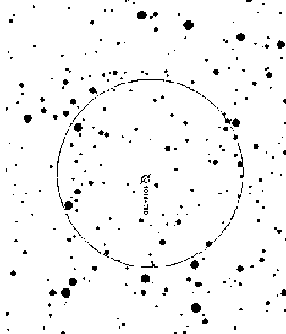 Megastar field; same orientation, approximately same scale. Circle represents 22' 9-Nagler (222x) field. |
|
Dick Flasck's Observing Notes on Above Quasar:
Subject: QSO observing notes 8/4/99
Date: Sun, 05 September 1999 01:59 PM EDT
From: RFlasck
Quasar hunting notes 8/4/99
Target: HS 1946+769
Type: QSO
Mag : 15.9
Z = 3.02
Const: Draco
Equipment:
Homebrew 17.5" trusstube Dob with Discovery mirrors, FL: 1816mm
Homebrew Poncet / Purcell platform
EP's: 50mm Orion, 11mm Nag, 9mm Nag, 7mm UO, 4.8mm Nag
Location / Conditions
Lake Sonoma
10 - 11 pm
seeing: 5
naked eye limiting mag: about 6.0 - some slight smoky haze from the fires
Thanks to Steve Gottlieb and Ray Cash for the initial info that got me started hunting down QSO's. HS 1946+769 is the farthest object I ever expect to visually observe. It is over 11 BLY's away.
The hunt started with a series of detailed star charts generated on Megastar. 1946 is not close to any really bright star, so I decided to starhop from Tau 60 Dra. The hop required over 3 fov's of the 50mm Orion EP.
When the star field containing 1946 was positively identified, I pulled out the old trusty 11mm Nagler. The QSO is near the end of a pretty curving star chain (of mag 13ish stars) running north to south. The chart showed it about midway between the last two stars and slightly west. Nothing was visible with the 11mm at that location. In fact a closeby 15.5 mag star would only pop into view 10% of the time with averted vision.
Next came the 9mm Nagler. The 15.5 star held steady with averted vision. Over a period of 10 minutes, the QSO MAYBE popped into view twice - for less than one second. The wind was picking up a bit, and I knew the clock drive on the EQ platform was running out.
I tried the 7mm UO hoping for more contrast. No Joy. I even lost the 15.5 mag star.
In desperation, I pulled out my 4.8 mm Nagler. I rarely use this EP since the seeing rarely supports it. Surprise! 1946 jumped right out - I could see it with direct vision. Nearly everyone in the group last night got a look. Some could see it only with averted vision. About half could see it with direct vision.
It just looked like a faint star, but that was ancient light from the edge of the observable universe. Cool!!
Dick